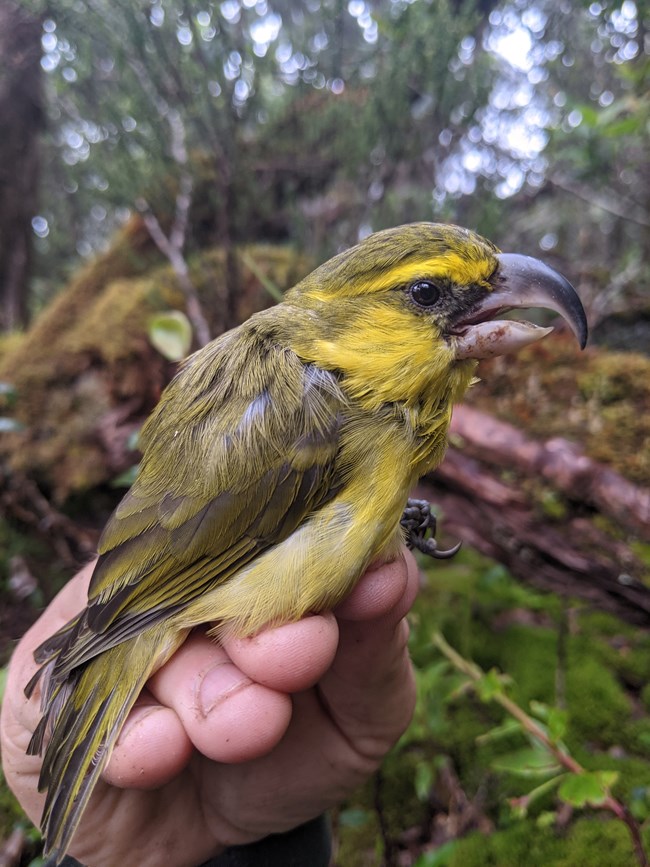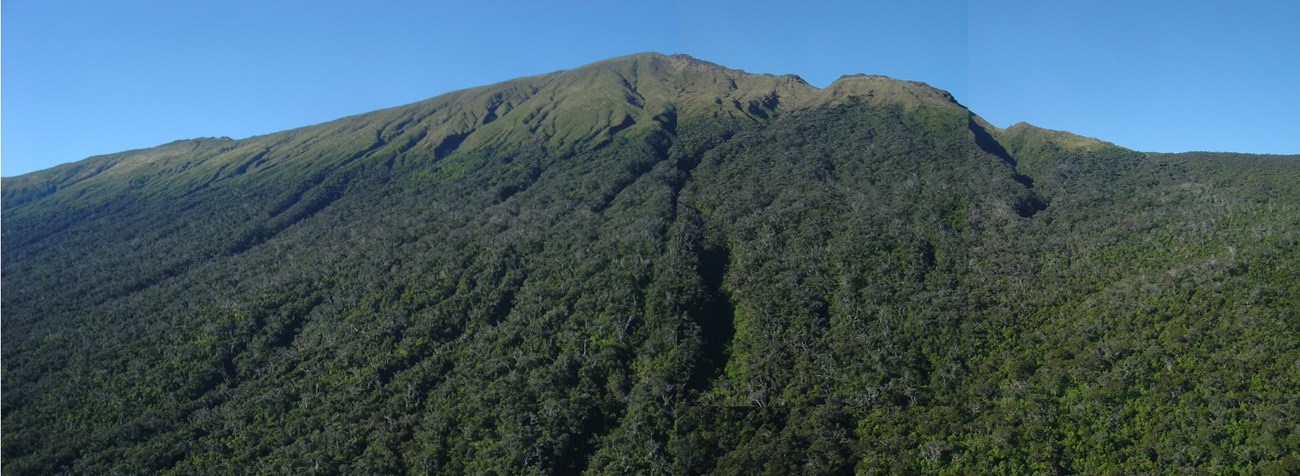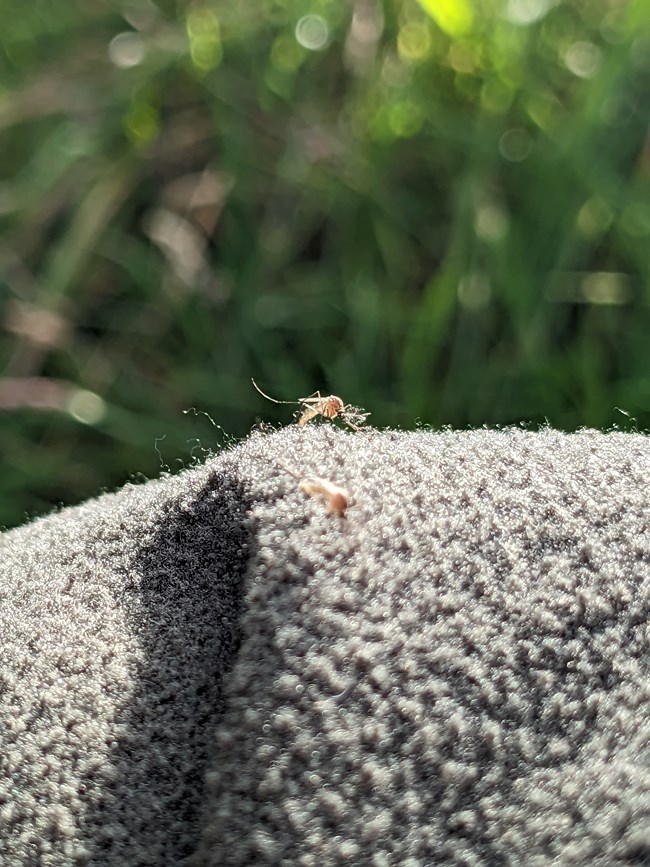Last updated: January 17, 2025
Article
Haleakalā National Park: Resisting climate-enhanced threats of avian malaria

Photo by C. Warren (NPS/Maui Forest Bird Recovery Project)
Avian malaria, the deadliest of the threats to Hawaiian honeycreepers, spread through the islands in the early 1900s after the arrival of disease-carrying mosquitoes. Driven by habitat loss and disease, honeycreepers disappeared entirely from lower-elevation forests. Birds on older, more eroded Hawaiian islands like Kauaʻi have been at a particular geographical disadvantage because all but the flat tops of the tallest mountains have long been within mosquitoes’ reach. In comparison, birds on Maui, a younger and taller island, have high-elevation strongholds—the band of cloud forest known as Wao Akua that Native Hawaiians consider sacred—high up on the slopes of Haleakalā Volcano. Now, warming temperatures are expanding the mosquitoes’ range upward through the forest. At the same time, managers worry that climate change may also drive the upper edge of the cloud forest downward through its effects on the trade wind inversion, a stable boundary (at about 7000 feet above sea level) common over tropical oceans between a moisture-rich lower air mass and an extremely dry upper air mass.

Photo by G. Schuurman
Hawaiian Honeycreepers In Crisis
Trapped in a potentially shrinking band of cloud forest now starting to swarm with deadly mosquitoes, Maui’s remaining forest birds are in imminent danger. Haleakalā National Park’s staff and collaborators are racing against a wave of avian malaria to keep these native species alive. Fewer than 200 kiwikiu, for example, are left in the wild, down from a population of roughly 500 that had persisted from the 1980s into the 2000s. Meanwhile, Kauaʻi has already seen the impact of warming temperatures on an island-endemic Hawaiian honeycreeper called the ‘akikiki, which dropped from approximately 450 individuals in 2018 to just 5 individuals in 2023. As of 2024, a single ‘akikiki is known to be in the wild, rendering the species functionally extinct in the wild (fortunately, a small captive population was established a few years ago). With upwards of 95% mortality as soon as nine days after a bite from an infected female mosquito—and the population of Maui’s kiwikiu dwindling—Haleakalā’s birds needed an emergency rescue to avoid the same fate.
How can environmental stewards protect wildlife against an expanding aerial plague? Haleakalā National Park is resisting Hawaiian honeycreeper extinction with two efforts, one traditional and one novel. The first has been to locate the population centers of the most endangered forest birds and focus conservation efforts there. Several decades of management — including ungulate and weed control — have successfully protected native forest habitat, but with the number of birds plummeting due to a pervasive new stressor moving through the forest, managers recognized that this knowledge and the traditional conservation approaches it supports were insufficient. Haleakalā National Park had to expand their strategy with a second, more novel effort: taking on the new stressor—the mosquitoes—directly. The National Park Service, in collaboration with the Hawaiʻi Department of Land and Natural Resources, The Nature Conservancy, the American Bird Conservancy, and others (collectively known as Birds, Not Mosquitoes) began working together to develop and apply methods to suppress mosquito populations as a means of controlling avian malaria.
Understanding the RAD Framework
The RAD framework consists of three strategies:
- Resist: Working to maintain existing conditions or slow the rate of change based upon historical or acceptable current ecosystem conditions. This often involves direct interventions to counteract environmental changes.
- Accept: Allowing the system to change without intervention.
- Direct: Actively steering changes toward desired outcomes, which may involve redesigning or repurposing systems to function under new conditions.

Photo by C. Warren (NPS)
An Innovative Conservation Strategy
The most promising candidate for that management was the Wolbachia incompatible insect technique (IIT). Unlike genetic modification strategies, IIT relies on Wolbachia—a bacterium that lives naturally within most insects and prevents their insect host from producing viable offspring with partners that have even a slightly different strain of Wolbachia. Unlike sterile insect techniques (SIT), mosquitoes with mismatched Wolbachia can still breed, but their resulting eggs will not hatch. As a quirk of mosquito reproductive biology, a female mosquito mates only once and will not mate again. This aspect of mosquito natural history presents an opportunity to create a safe method to reduce mosquito reproductive output by inoculating lab-bred male mosquitoes (which do not bite) with an incompatible strain of Wolbachia and releasing these males on Maui where the wild females they mate with produce inviable offspring, causing the mosquito population to decline. This effort therefore uses a natural process to try to protect forest birds without harming the environment, humans, or other animals. Although similar mosquito control methods have been used worldwide to protect humans from mosquitoes and mosquito-borne diseases such as dengue, Zika, and chikungunya, this is a frontier for conservation in national parks.
“That’s the pressure we’re feeling with this. Any delays are distressing. We are not jumping in too fast—we have done the requisite small-scale studies, and now the rubber is meeting the road. We are doing it, and then we’re learning how we’re going to do it better as we do it,” said Chris Warren, the Forest Bird Program Coordinator for Haleakalā National Park. “The only thing that’s more tragic is if [the birds] went extinct and we didn’t try. You can’t not try.”
Beyond Boundaries: Collaborative Strategies to Protect Forest Birds
In November 2023, Haleakalā National Park and its partners launched their innovative management strategy by releasing batches of Wolbachia-incompatible male mosquitoes into the wild. The group planned to make these deliveries twice a week, using drones or helicopters to drop capsules that resemble large, biodegradable Keurig pods filled with thousands of male mosquitoes.
In meeting with each other, HALE and its partners aimed to, as much as possible, work on this project irrespective of boundaries. The NPS empowered their collaborators to conduct monitoring and mosquito releases within Haleakalā, and the same groups are extending their efforts outside of park boundaries—and outside of Maui—to rescue Hawaiian honeycreepers from extinction. Relfecting on this project in early October, Chris Warren stressed how important everyone's cooperation was during the adaptation process.
“One of the best things about this whole project is how collaborative it’s been," he said. “The birds don’t care where the boundaries are.”
